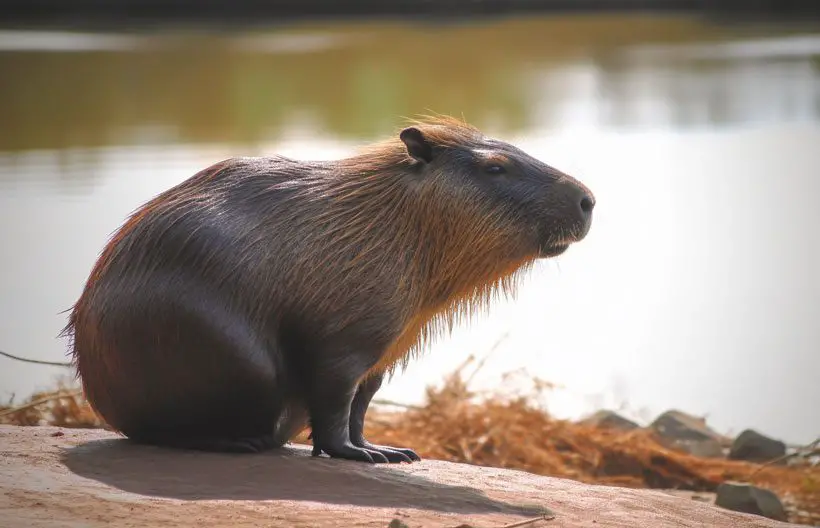Eight Fascinating Capybara Facts: Discovering These Unique Animals
Capybaras are often confused with wild guinea pigs from a distance. However, capybaras have exciting life facts that make them unique from other rodents. Some of these fascinating facts are physical, while others are behavioral.
So, what are the fascinating capybara facts? Capybaras are the largest rodents in the world, weighing up to 145 lbs with a body length of 100-134 cm. They are semi-aquatic, feed on their fecal matter, and have a 4-10 years lifespan. Capybaras can run at an average speed of 35 km/h.
This article reviews the top eight fascinating facts about the life of a capybara and the physical features that make it unique. In addition, it covers the scientific classification of these animals.
General Capybara Facts And Their Features: Quick Overview

Go through the following overview to get an idea about the main fascinating Capybara facts if you have a hurry. Otherwise, you can go through the article to learn things in detail.
| Habitat | Wetlands, green savannahs, tropical rivers, and in captivity |
| Location | South America (Except Chile), North America |
| Size | They are the largest rodents with a size of 106 – 134 cm |
| Weight: | 145 lbs |
| Color | Light brown to dark brown |
| Diet | Grasses, water hyacinth, plants bark, and vegetables |
| Predators | Green anacondas, ocelots, crab-eating foxes, alligators, caimans, and jaguars |
| Top Speed | 33-35 km/h |
| No. of Species: | 1 |
| Conservation Status | Low concern |
Fascinating Capybara Facts: Discovering These Unique Animals
These giant pig-like rodents have gained popularity as pets due to their high instincts and social interactions with humans and other rodents.
They have fascinating and outstanding behavioral and physiological features that make them unique.
1. Capybaras Are Semi-Aquatic Species
They love swimming and live in and around water bodies such as lakes and water ponds. Capybaras spend most of their resting time in the water with their body partially submerged, exposing only the head.
Sometimes they get fully immersed in water for approximately five minutes to cool down their bodies or hide from predators. When the climate is favorable, they leave the water and feed on grass and tree barks in the tropics and green savannah.

2. They Are The Largest Rodent Species In The World
Capybaras weigh between 35 and 66 kgs – approximately 145 lbs for mature adults. It is recorded as the world’s largest rodent, making it an interesting animal to keep as a pet.
They grow up to 134cm, with a height of approximately 30 cm. Males are slightly larger than females as females only reach 55 kgs (120 lbs).
3. They Eat Their Own Feces
Capybaras are known to be auto-coprophagous. That means they feed on their poop since it contains bacteria that help digest the cellulose in plant matter, tree barks, and water plants.
4. Birds And Other Small Animals Love Sitting On Them
Capybaras enjoy other animals sitting on them, unlike rodents that seem to be scared by any approaching animals.
Birds feed next to capybaras as they graze and sit on its head without being chased away.

5. Continuously Growing Teeth
From their herbivore nature, their teeth get worn out while grazing and knocking on tree barks. Their feeding habits require strong teeth that continuously grow to replace worn-out or broken parts.
6. They Are Social And Are Kept As Pets
Capybaras are highly intelligent and have high social-interaction instincts with humans and other rodents. One can quickly bond with these animals with some training and time together.
Some States have legalized their adoption, selling, and buying. With an approved license, you qualify to keep capybaras as a pet.
7. They Can Also Run As Fast As 35 km/h
Capybaras are also among the fastest rodents despite their massive body size. They run at an average speed of 35 km/h, especially when running from danger.
8. Capybaras Can Swim And Sleep On Water
They use their short legs to wade through water. Their feet are webbed to help them swim without drowning.

Capybaras can also sleep while in water by floating on the water. They leave their head out of the water to breathe and watch for predators. Another amazing fact is that they can hold their breath for up to 5 minutes underwater.
Capybara Behavior: Understanding These Unique Animals
In the wild, capybaras’ social structures and dispersal patterns portray a high level of social skill by living in small groups of about 20 to 30 capybaras. They have a family unit similar to that of a man.
The group has a dominant male and a few female capybaras and their young ones. The dominant male is the head and protects the family unit.
In captivity, keep them in pairs with the opposite sex to avoid fights and give them enough space to play and exercise. They exhibit behaviors such as barking, squealing, and purring with good company. Watch this video of sounds made by capybaras.
Their social instincts are seen in play when they cuddle and play with each other. They are also intelligent and can quickly learn and understand their names after some time.
They create a strong bond with their owners if treated well and disciplined cautiously. Otherwise, they bite when irritated or in danger.
Scientific Classification Of Capybara
Capybaras is the largest rodent in the world, weighing up to 145 lbs. They are classified under the following taxonomic groups.
| Taxonomic Group | Scientific Name |
| Kingdom | Animalia |
| Phylum | Chordata |
| Class | Mammalia |
| Order | Rodentia |
| Family | Caviidae |
| Genus | Hydrochoerus |
| Species | Hydrochoerus Hydrochaeris |
Capybaras (Hydrochoerus Hydrochaeris) are found in thick forests and zoos. They are considered as least threatened species by IUCN but they face constant habitat loss and predation. These species are expensive to own and maintain but worth the experience.

FAQs
Let’s look at some of the frequently asked questions concerning capybara.
Q: How Long Do Capybaras Live?
Capybaras can live in cages for 8-12 years with proper care and protection. They can live for up to 4 years in the wild and natural habitats.
The difference is brought by the healthcare provided, protection from predators, and habitat loss.
Q: Are capybaras Related To Guinea Pigs?
Yes. Capybaras are related to guinea pigs from the Caviidae family. They have similar physical features such as short limbs, thick fur, and rounded boozy with furry tails.
However, capybaras are larger than guinea pigs and are adapted to a semi-aquatic lifestyle.
Q: What Do Capybaras Eat?
Capybaras are herbivores meaning they feed on herbs, grass, tree barks, water hyacinths, and aquatic plants. When domesticated, you can supplement their diet with pellets and fruits.
Conclusion
Unlike many rodents, capybaras are unique, being the largest rodent species in the world, mainly in South America. They weigh up to 145 lbs and grow to 134 cm long. Capybaras have short and webbed feet to help pin swimming and keep up with their fast speed of approximately 35 km/h.
They feed on their poop, and tree barks with solid teeth that grow continuously as they wear out. Many people keep them as pets in the United States since they are social and calm.




